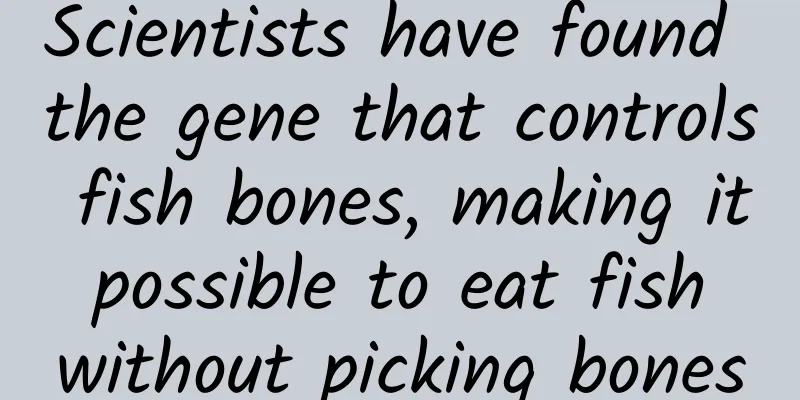Scientists have found the gene that controls fish bones, making it possible to eat fish without picking bones

|
There are often such troubles in life Crucian carp is delicious, but has too many bones Bream is tender and easy to get stuck in the throat recently College of Fisheries, Huazhong Agricultural University Professor Gao Zexia's team Gene found to control fishbones Eating fish without picking bones will become a reality Professor Gao Zexia is conducting an experiment. Do you know fish bones? The scientific name of fish bones is intermuscular bone, which is formed by the ossification of tendons in the diaphragm. From the perspective of the source of formation, the reason why fish bones grow is actually the same as the reason why humans grow bone spurs. In addition to being troublesome when eating, fish bones are also an important obstacle to large-scale mechanized processing. Thorn extraction is divided into 4 steps Click to see the full picture↓↓ 1 Three months of "picking faults" Nearly 50 candidate genes were screened On December 18, a reporter from the Yangtze River Daily interviewed Professor Gao Zexia in the Gene Building of Huazhong Agricultural University, and heard her talk about the ins and outs of choosing "boneless fish" as a research topic. In 2012, Gao Zexia, who had just graduated with a doctorate, faced a "transformation" project: how to make bream not only more productive and better-quality, but also popular in the fish pond and on the table. She chose to make bream boneless. She said: "Many people have experienced fish bones stuck in their throats, so I want to breed boneless fish, which may be a direction for the development of the bulk fish industry in the future." Some fish have thorns, some do not, some have many thorns, and some have few thorns, all because there is one or several key genes that regulate them. Therefore, the key to "creating" thornless fish is to find the gene (major effect gene) that plays a major role in regulating the growth of fish bones. This is a completely new field. Previous studies on fish bones have mostly focused on morphology and phenotype, with little attention paid to genetics and molecular regulation. Professor Gao Zexia described to reporters the process of searching for fishbone gene molecule expression: they carefully picked out each bone from the bream, removed the connective tissue, quickly put it into liquid nitrogen for storage before degradation, and then quickly extracted RNA and performed gene expression. It was said to be fast, but it took the entire team three months to come up with high-quality fishbone RNA from picking out the fish bones one by one to completing gene expression. They eventually screened out nearly 50 candidate genes. Because the "fishbone picking" procedure was very professional and accurate, the method of extracting RNA was improved and the world's first comprehensive fishbone gene expression was achieved, Gao Zexia applied for the first domestic patent in fishbone research. 2 7 years of searching and a "misunderstanding" Missed the Boneless Bream Twice They put nearly 50 genes found in bream into the standard model fish zebrafish for verification. The verification process is a bit like opening a blind box. Using gene editing technology, they knocked out these genes one by one to see if there was any change in the growth of fish bones and how it changed. Zebrafish can reproduce a generation in three or four months, which can effectively speed up the progress of the experiment. Even so, the verification process took 7 years. Gao Zexia, who is now a national expert in Wuchang fish research, did not dwell on the twists and turns, monotony and repetition in the process, but could not help laughing at an "oolong incident". After knocking out a gene in zebrafish, a boneless fish was discovered. The whole lab was excited, and everyone had a feeling of "finally finding it". However, when they went to verify it again, they found that the bones of other fish in the same batch as this boneless fish were still there, proving that this discovery was just a beautiful mistake. Gao Zexia smiled and said that she still didn't understand why there was a boneless fish mixed in with the boneless fish. It might be a natural gene mutation. Science is so tortuous, and trial and error is the norm. She also told a story about Academician Gui Jianfang from the Institute of Hydrobiology, Chinese Academy of Sciences, who has been paying close attention to the research progress. Academician Gui had twice eaten boneless bream, but unfortunately he discovered while eating it that the genetic genes had not been retained. 3 The bones have changed, but the fish remains the same This "blunder" made Gao Zexia more cautious. They edited about 40 genes and finally found an "effective" gene in 2018, which can reduce 70% of fish bones. Only a few bones are left at the tail, and all the bones on the back are gone. Is "effective" the same as "main effect"? Gao Zexia was a little unsure. At this time, a surprising news came from faraway Brazil. A dozen naturally mutated spineless "great carp" were accidentally discovered in the Amazon Basin. They were not less spines, but completely spineless. Although this discovery did not really help her research, it was like a ray of light in the darkness. She realized that the gene that could reduce 70% of spines must not be the main effect gene, and she still needed to find it. This gave them a pin to stabilize the sea. With a goal and a path, they continued to open the genetic blind box. One day at the end of 2019, Gao Zexia said, "all of a sudden," the major gene appeared, and this time it was really a spineless zebrafish. The spineless phenotype of hundreds of fish was very stable, and after several generations of breeding, the offspring zebrafish were also spineless. It can be confirmed that what was found was the major gene, which is a common gene contained in all spiny fish. After testing, it was found that although the fish bones had changed, the amino acid and fatty acid content in the fish meat was not significantly different from that of ordinary boney fish, and the meat texture remained unchanged. 4 True boneless fish It is expected to be served on the table of citizens After finding the major gene, Gao Zexia's team conducted further positive verification by transplanting the gene back into spineless fish to see if they would grow spines again, further confirming the role of the gene. On the other hand, they applied for and obtained national authorized invention patents for the genes that reduced spines by 70% and 100%, and promoted them to various domestic research groups as public information, in an effort to apply this gene to different fish. At present, Gao Zexia's team and Academician Gui Jianfang's team from the Institute of Hydrobiology, Chinese Academy of Sciences have experimented with knocking out the main genes that regulate fishbone growth in bream, grass carp and silver crucian carp respectively. The first-generation hybrid (F0 generation) of fish with few spines obtained grew well, had normal morphology, and had habits that were no different from those of ordinary fish with spines. The bream in Wuhan matures once every two years, and the crucian carp matures once every year. These mature hybrid few-bone fish are then purified and reproduced for one generation. By the third generation (F2 generation), we can obtain homozygous, truly boneless fish with stable genetic traits. At the same time, the swimming ability and nutrition of boneless bream still require detailed research by scientific researchers. "I believe that boneless fish will be an upgrade to the bulk freshwater fish industry and family dietary structure." Gao Zexia said confidently. Source: Yangtze River Daily Written by: Reporter Zhou Jie Image: Compiled by Peng Xuewu Map by Liu Yan Editor: Gao Yang Proofreading: Wang Bei |
Recommend
If you are sick, can intravenous infusion help you get better quickly? The answer may not be what you think
Author: Zhao Zhigang, Chief Pharmacist, Beijing T...
Wansan Goods Mixed Cut Training Camp: A course for beginners to sell goods and realize cash flow
Wansan Goods Mixed Cut Training Camp: A Course fo...
How does private domain operation conduct private domain operation?
Burning money, building up scale, raising funds, ...
APP promotion: Detailed explanation of ASO promotion in Apple Store!
ASO traffic entrances are divided into app store ...
Fake "Lizard"
Nothosaurs are a type of Sauropoda, mainly found ...
Want to save advertising costs? Don’t waste money? Learn to find the right one
As Internet advertising is booming and competitio...
TopNews is a high imitation of the "Today's Headlines" client
Source code introduction: TopNews is a high imita...
Is the small belly to protect the uterus and ovaries? Doctors warn: Storing too much abdominal fat is very harmful!
"Women's small belly is to protect the u...
A female internet celebrity weighing 312 pounds died in a weight loss camp! For severely obese people, this weight loss method is more reliable than excessive exercise
Recently, the news that the 312-pound internet ce...
ASO Optimization: Detailed Explanation of App Store Ranking Rules
ASO optimization obviously affects the first step...
Selling tickets is just the beginning. There is still a lot that "Internet +" movies can do.
Film has always been one of the industries closes...
Mercedes-Benz parent company's profit dropped by 37% as sales in China slowed
According to the Wall Street Journal on the 29th,...
The existential comfort of atheism
Leviathan Press: Even though I currently believe ...
Bluecore: The greatest value of artificial intelligence in the marketing industry in 2020 is personalization
What was most notable in 2019 was the maturation ...
How to operate a product in Jianshu
1. Product positioning Jianshu is a product that ...









